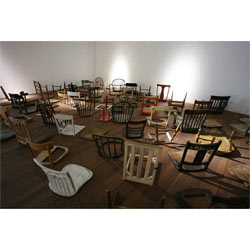
Artists saddled with nationalities designated by the names of two countries positioned on opposite sides of a hyphen (Mexican-American, African-American, Japanese-American, etc.) vary in their ability and passion for acknowledging and infusing rudiments of their cultural birthright into work produced in their adopted countries. New York resident Sook Jin Jo exemplifies those who have successfully managed to apply sensitivities honed in their homeland to interrogations and interpretations of social and cultural enigmas encountered elsewhere.
Born in Gwangju, Korea, Jo received an MFA degree at Seoul‘s Hong-Ik University in 1985. Embracing the cultural respect for wood long established in Korea and seeking affordable material to use in her art, Jo began working the margins between painting and sculpture with repurposed plywood. Three years after her graduation, Jo elected to take up residency in New York, completing a second MFA degree at Pratt Institute in 1991.
Since her first American solo exhibition at O.K. Harris in 1990, Jo has continued to work primarily with abandoned wood, using it to make drawings, collages, performance pieces, sculpture and site-specific installations in projects that increasingly engage her interest in reclamation and rejuvenation. Recently at New York’s Lower East Side Tenement Museum, a space where contemporary artists deal with issues of concern to immigrants, Jo collaborated with ESL students from the Jacob Riis Neighborhood Settlement House in a site-specific installation addressing death, mourning and rehabilitation.
Rehabilitation and respect appear as crucial elements in Jo’s site-specific installation, “Wishing Bells, To Protect and Serve,” on view off site from the gallery and commissioned by the Los Angeles Department of Cultural Affairs. Located at the public plaza at 180 N. Los Angeles Street, in front of the entrance to the new Metropolitan Detention Center, Jo was aware that the site encroached upon nearby Little Tokyo, a long established cultural and religious core, and home to the Japanese American National Museum and the Nishi Hongwanji Buddhist temple. She managed to honor traditional Japanese customs as well as the police department’s sense of purpose, constructing a monumental Zen–like installation that is infused with spiritual resonance.
“Wishing Bells” features nine columns made of centuries-old cedar, representing the five members of the board of police commissioners and the four star insignia of the chief of police. The columns support a grid hung with 108 bells, commemorating the Buddhist New Year’s Eve ritual in which temple bells throughout Japan are rung 108 times. Each toll of a bell is believed to dispel one desire or defilement that may be a cause of suffering. Hanging from the bells are metal clappers engraved with texts contributed by members of the LAPD and the Little Tokyo community. As the bells chime, words such as integrity, dignity, openness, peace, forgiveness, reverence, responsibility and honor send out messages of hope to prisoners, their families and members of the community. Jo feels that the bells remind prisoners of the passing of time, but also sooth them by evoking eternity, thus giving them hope of salvation in the future. She trusts that “meditating on the bells, they transcend their condition, beginning an emotional healing process that is the first step toward social rehabilitation.”
In nearby Chinatown Jo reconstitutes her instillation, “Chairs,” initially exhibited at the Museum of Art of Seoul National University in Korea. Chosen from a group of nearly 200 carved wooden chairs found and collected from the streets of New York by the artist over the last ten years, each chair re-assembled in Los Angeles carries its own history and presence. The chairs rest like warriors who have lost their limbs in battle, some with their disjointed legs upended nearby. They have been purposefully turned towards the gallery wall, lit to promote the suggestion of focal points made available for the projection of stories rising out of the viewer’s imagination. Unlike the uniformly ordered rows of padded theater seats in Hiroshi Sugimoto’s famed time lapse movie house interiors that stare at screens blanched white by hours of projected light, each of Sook Jin Jo’s chairs retains its distinct individuality. Crafted of wood, proudly bearing scars accumulated over time, they rally viewers to contemplate and cherish whatever they hold dear.
Published courtesy of ArtScene ©2009
